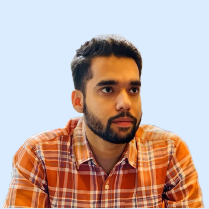Are your customers waiting in long call queues to find answers to quick questions like final bill amounts or steps to use a product? Beware, as long wait times are spoiling their customer experience. Rather, consider implementing self-service automation.
Adopting self-service enables businesses to annually save an average of $1-3 million. Not only that, but automating self-service will also save you time.
Leverage these benefits by understanding self-service automation with its best implementation practices, success metrics, and challenges (+solutions) in detail.
When establishing self-service automations, keep each automated answer information-rich with detailed concepts. Make sure to add relevant, high-search keywords in self-help articles so even automations can find and recommend query-related articles based on keywords. Review your self-help articles regularly so they are always updated.
AI-Powered Self-Service: Faster Support, Smarter Solutions
Self-service automation is a technology-driven approach that allows customers and employees to find solutions, complete tasks, and resolve issues without human intervention.
Examples of Self-Service Automation in Businesses
- AI Chatbots & Virtual Assistants – Provide instant, automated responses to customer queries.
- Knowledge Bases & FAQs – AI-powered search recommendations for quick issue resolution.
- Employee Onboarding Automation – Streamlined HR processes, including document submissions and training.
- IT Self-Service Portals – Automate password resets, system access, and troubleshooting.
- Email Ticketing Systems – AI-driven customer support automation for faster issue resolution.
Key Technologies Powering Self-Service Automation
- AI & Machine Learning – Enables personalized responses and predictive solutions.
- Natural Language Processing (NLP) – Improves chatbot interactions and knowledge base searches.
- Robotic Process Automation (RPA) – Automates repetitive tasks like approvals and form submissions.
- Conversational AI & Voice Assistants – Enhances customer interactions through natural conversations.
Implementation & Performance Measurement
Implementing self-service automation involves integrating AI, deploying chatbots, and optimizing workflows. Businesses measure success through customer satisfaction (CSAT) scores, resolution rates, and user engagement metrics.
Challenges & Solutions in Self-Service Automation
- Limited Searchability? Optimize the knowledge base with AI-driven suggestions.
- Lack of Human Escalation? Implement chatbot-to-human handoff.
- Personalization Issues? Use AI analytics for a better user experience.
Future Trends in Self-Service Automation
- AI-Powered Voice Assistants – Conversational AI for seamless user interactions.
- Hyper-Personalization – AI-driven recommendations based on user behavior.
Omnichannel Integration – Unified self-service experiences across multiple platforms.
Self-Service Based Helpdesk Automation
Self-service-based helpdesk automation relies on self-service technology to empower customers to independently solve their queries without human representatives. It allows customer service desk teams to automate support tickets or requests.
Example: Cloud phone systems have in-built call routing or virtual receptionist features that offer answers to FAQs or route customers to the appropriate department based on the number they press during the IVR session.
So, you see how self-service automation frees agents from answering the same questions or performing manual tasks. With these automations, businesses reduce agent burden, cut costs of maintaining a huge team to cater to all the queries manually, and allow agents to better plan customer journeys or workflows. Beyond reducing expenses, automation also helps optimize resource allocation and improve overall operational efficiency, ensuring businesses get more done with fewer resources.
Some other benefits that self-service-based helpdesk automation brings are-
- Automation, like AI-powered chatbots, promotes proactive assistance to customers by initiating a conversation, collecting query details, and providing relevant knowledge base resources.
- Self-service automations customize the content based on customers’ needs to deliver a more personalized solution.
- It also speeds up the resolution by quickly directing the case to a support agent when it is unable to solve the issue.
- Fulfills customer expectations as 67% of customers prefer self-service over connecting to a company representative.
Self-service automation tools can help businesses become more efficient because they allow users to get things done without relying on a human. They relieve humans of work while providing service to customers more quickly and accurately. Check out some of the most useful self-service automation technologies available:
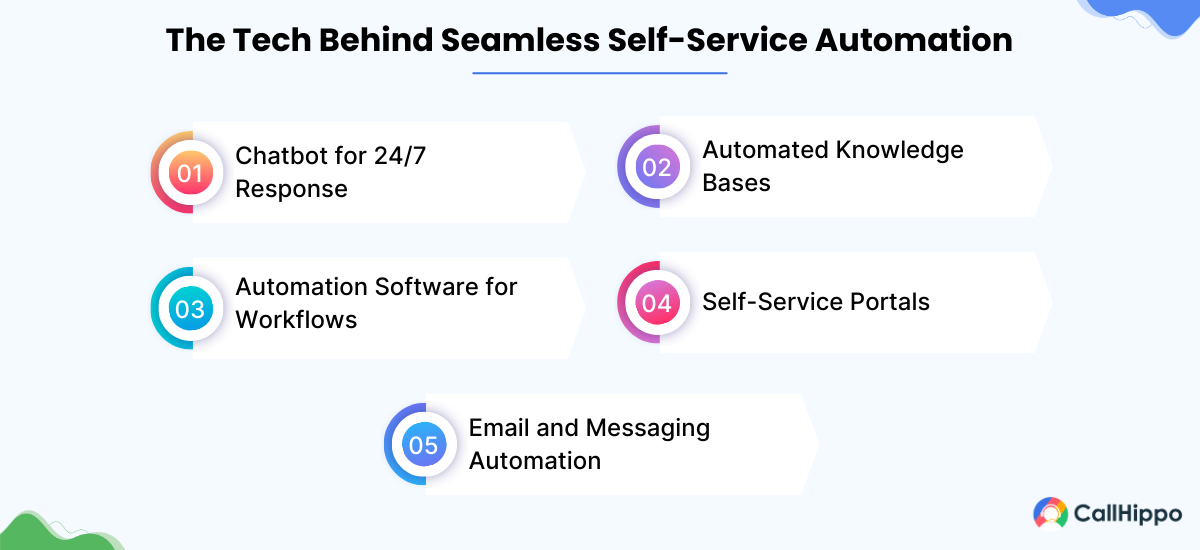
1. Chatbot for 24/7 Response
Chatbots are a common self-service automation technology that provides instant responses to users’ questions. They help users find information, troubleshoot problems, and even complete transactions without having to speak to a human.
Chatbots can be implemented on websites, mobile applications, and messaging channels, making them available 24/7. They support the human workforce by helping users with simple steps to automate workflow and thereby freeing people for non-simple customer support cases.
Note – Chatbots are capable of directing customers to the appropriate knowledge base, FAQ page, or online discussion forum when needed.
2. Automated Knowledge Bases
A knowledge base, or electronic library, is filled with users’ frequently asked questions, directions on how to perform tasks, and potential solutions to solve problems.
Automated knowledge bases utilize the search function and categorize questions/answers to help users quickly find relevant information. Automated knowledge bases can reduce the number of support tickets while helping employees and users learn how to solve problems independently.
3. Automation Software for Workflows
Workflow automation solutions allow organizations to establish pre-designed workflows that anyone can invoke without a person needing to become involved. Workflows simplify the review and approval process, document processing, and service requests.
For example, employees need to submit IT requests or HR forms, followed by an automated workflow assigning responsibility and tracking the progress of the request to be updated automatically within the workflow. Workflows help prevent bottlenecks and move processes forward without ongoing human monitoring.
4. Self-Service Portals
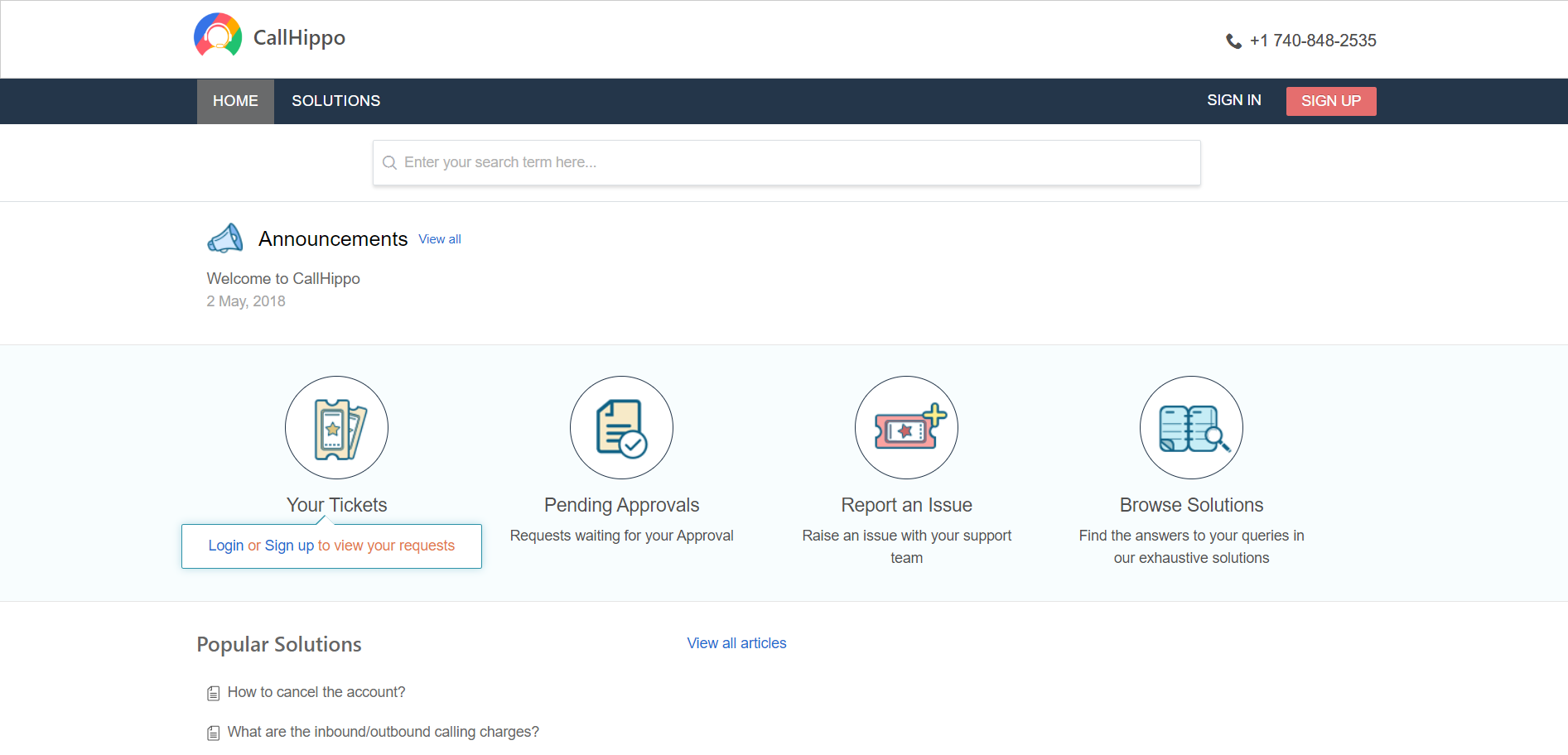
Self-service portals allow users to access a tool or service in one location. For example, customers can check the status of an order, update instructions or accounts, or manage subscriptions without contacting the support team.
Employees can access company self-service portals to request leave, download payslips, or complete training modules.
5. Email and Messaging Automation
Automated emails and messaging systems allow businesses to provide instant responses and confirmations. Depending on the request or concern, the individual will automatically receive an email along with the request, expediting the process without relying on human communication.
For example, password reset emails, appointment reminder emails, and confirmation of purchases all happen automatically and contribute to a smoother customer experience. Email and messaging automation also exist in text messaging and chat applications as well, providing an opportunity for companies to converse with a user across more than one channel.
With CallHippo
- Create IVR Menus
- Customize Greetings
- Improve Customer Experience

4 Real-World Examples of Self-Service Automation
Self-service automation is now being developed across industries to solve repetitive tasks more effectively. Here are a few self-service automation examples for you:
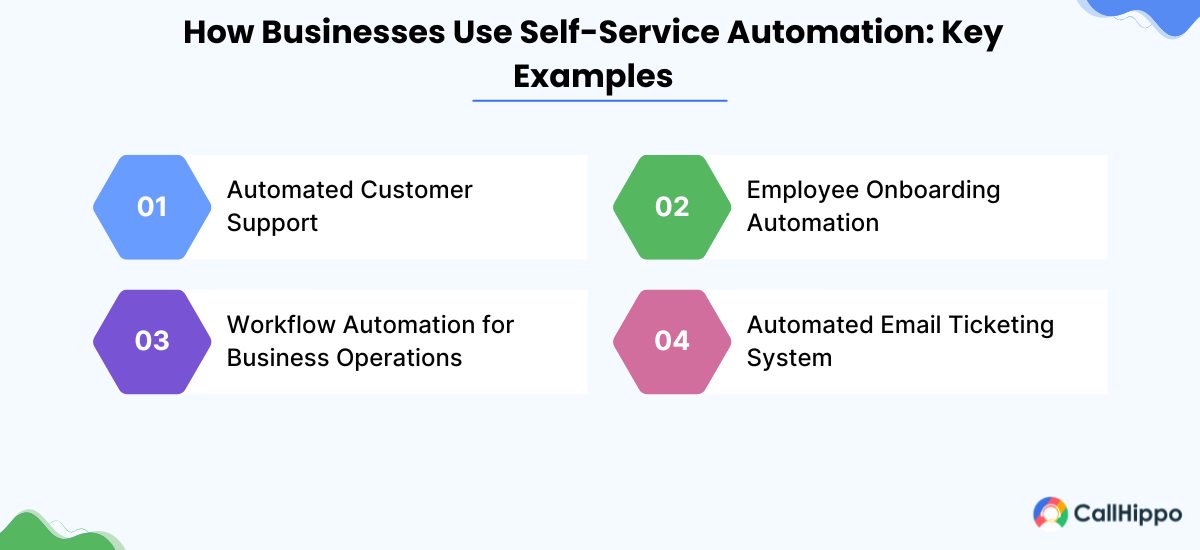
1. Automated Customer Support
A lot of businesses are now using automated self-service tools to help customers without involving an actual person. Automated customer support tools like chatbots and AI knowledge bases allow customers to self-serve by successfully answering FAQ types of questions, such as how to change a password, track an order, troubleshoot an issue, or understand company policy.
Automated self-service tools reduce the number of inquiries coming into customer support departments, allowing them to spend their time answering more complex inquiries and increasing customer satisfaction and response times.
2. Employee Onboarding Automation
Hiring a new employee can be a heavy task to present manually if you use traditional methods. Self-service automation takes care of repetitive tasks like collecting all documents, assigning training or compliance modules, creating accounts, and even automated emails for welcome letters that can be completed without any manual intervention or action by staffing.
3. Workflow Automation for Business Operations
Routine business tasks like scheduling meetings, approving expense reports, and processing purchase orders can slow down operations if handled manually. Self-service automation allows employees to complete these tasks through user-friendly dashboards.
For example, an employee can submit an expense report, and the system will automatically check compliance, forward it for approval, and notify the employee once it’s processed. This reduces delays, minimizes errors, and improves overall efficiency in business operations.
4. Automated Email Ticketing System
Many businesses receive customer inquiries daily over email, from simple help requests to questions about product return policies. Reviewing each email can take time and effort. Self-service automation solves these problems by automatically categorizing emails, responding to frequently asked questions, and routing more complex inquiries to the appropriate department.
Implement & Measure Customer Self-Service Automation
Randomly automating customer service will never bring you the smooth workflows you’re expecting until you understand how it is impacting the customer experience. Achieve the highest impact of self-service automation by adopting best practices, measuring its success with metrics, and taking necessary actions for best results. Let’s go!
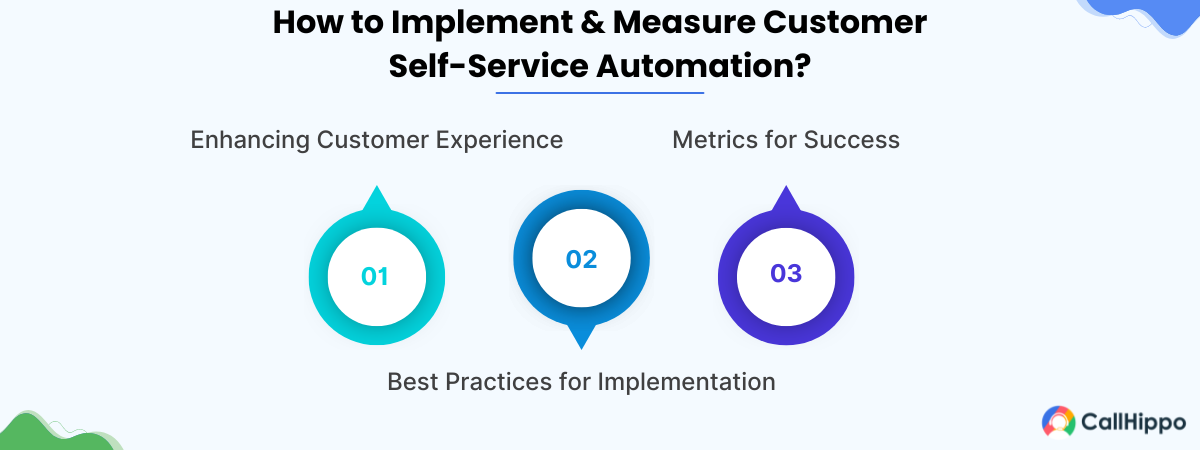
1. Enhancing Customer Experience
Most of the customers want to independently solve their issues without having to call your support team, wait in queue, or talk to multiple agents. Customer self-service automation tools help you provide this and hence improve customer experience.
- 88% of individuals reportedly expect businesses to provide a self-service customer support portal. Incorporating it in your helpdesk will fulfill their expectation, improve CSAT levels, and compete on customer support with competitors.
- With customers and service desk teams spread across different time zones, it’s inevitable to have customers waiting due to unavailable staff. Self-service tools let you offer support 24*7 so customers are never left hanging at any point of the day, enhancing customer experience.
- Self-service automation solutions ensure instant responses to customer issues with minimal wait times and no human intervention. Quick, independent resolutions are always convenient and satisfying for customers, improving customer experience.
- Generative AI actively evaluates customer data and personalizes responses or recommendations. This tailored and relevant support improves customer experience.
- Self-service automation tools provide support in different languages using generative AI. This helps customers with diverse language backgrounds to seek assistance in their language, adding to a positive experience.
2. Best Practices for Implementation
Here are the self-service best practices that can help you enhance your customer experience –
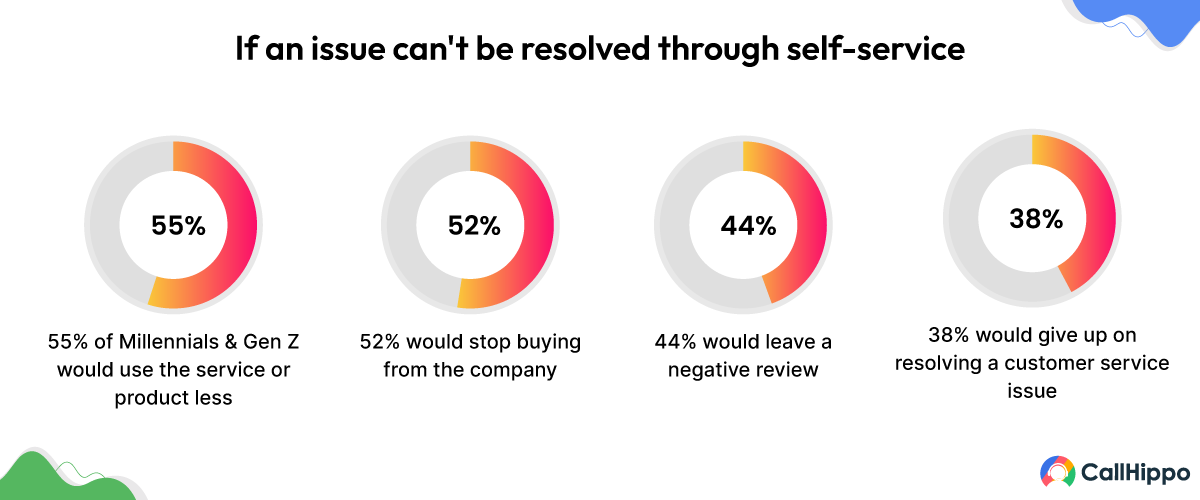
- Explore customers’ common issues to develop a winning self-service strategy. The best way to do this is to send out manual surveys, ask customers about their pain points by setting open questions on chatbots, or ask your contact center for common issues.
After you find out the common pain points, set up bot automation to resolve these issues.
Nearly half of the customers believe that they cannot solve queries independently because of little information available online. So, be careful.
- Give clear escalation options like a link to contact a rep, a callback option, or a human agent on chatbots.
For example, your business partners (business teams) must monitor live calls to gauge customer sentiments based on their language and barge in when needed. Doing so is important because automation won’t work well if it doesn’t allow customers to reach out to agents when necessary.
- Remember to review customer feedback at regular intervals to ensure automation is resolving customer issues. You can do this with post-call surveys, but they might not give you true feedback.
The best ways are call-performance ratings that offer insights into call patterns, CSAT (customer satisfaction scores), or KPIs like resolution and closure rates.
Evaluate these metrics to spot areas of the automation process you can simplify, personalize, or streamline to better fulfill customer expectations.
- Keep self-service options easy and accessible for all end users. So, they don’t need lessons on how to use it. Give clear instructions and an intuitive interface so your customers are never overwhelmed while navigating your self-service portal. This way, they can solve their issues efficiently and quickly.
3. Metrics for Success
Metrics for self-service automation success enable you to monitor its efficiency. It shows you improvement areas of your self-service and highlights your irrelevant support content. You can use these metrics to take measures and minimize customer dissatisfaction due to poor self-service experience.
Here are some major metrics you must measure –
Percentage of customer contacts via self-service
This refers to the percentage of customers who contacted an agent via self-service because they couldn’t find an answer.
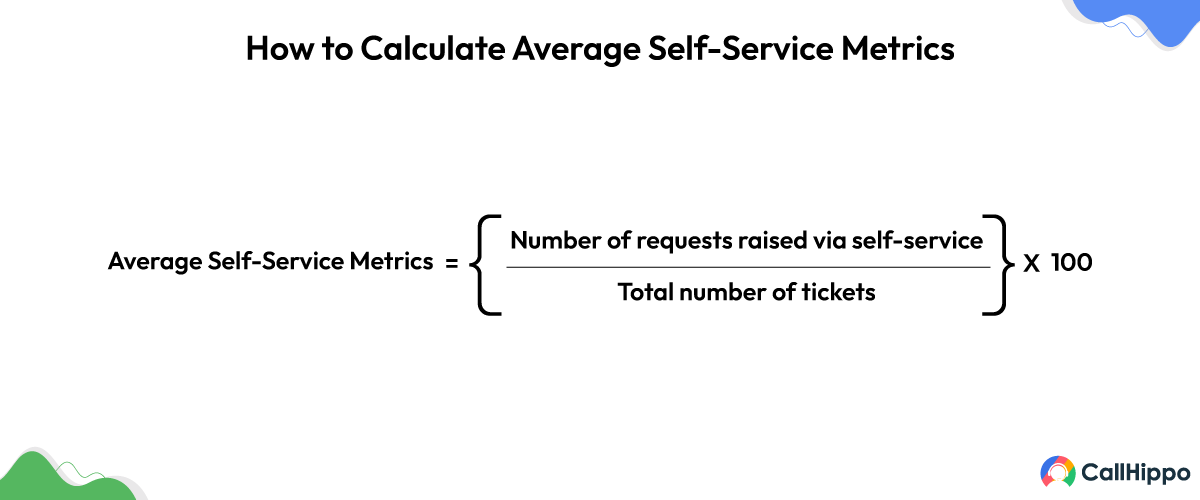
It assesses your self-service resources’ success in fulfilling customer queries. A high percentage signals a gap in self-service content and the need for improving self-service resources to better align with customer expectations.
Self-service portal performance
The self-service automation portal performance data gives you insights into the effectiveness of your knowledge base using a reporting mechanism. It shows most read articles, failed searches, and high or poorly-rated articles. For instance, high failed searches mean that customers are unable to find answers to the questions they are searching for through your automated processes.
Customer Satisfaction Score & Net Promoter Score
These scores signal how satisfied or unsatisfied customers are with your self-service. Measure CSAT scores with surveys to gauge customer happiness with your service. Ask them to rate your service.
Or rely on the NPS survey with questions like how likely they are to recommend your business. This shows customer loyalty and satisfaction.
Number of support calls
It indicates the effectiveness or ineffectiveness of your self-service. A drop in this number shows that people are increasingly adopting your self-service system, and agents have more time to focus on critical issues. If it’s high, your self-service isn’t resolving customer issues and needs significant improvement.
Bounce rate
This rate refers to the percentage of visitors landing on your knowledge base and leaving right away without exploring. Ideally, this rate should be low. You can ensure this by providing relevant content, explaining concepts clearly, cross-linking articles appropriately, and re-formatting the self-help portal.
Challenges and Solutions in Self-Service Automation
Self-service automation is not just a one-time job; rather, it’s a rigorous process full of challenges. In this section, we’ll list the major challenges you may potentially face with automation with proven solutions to tackle them –
1. Complex Chatbots
Most robust self-service tools and chatbots are insufficient to solve all customer queries. That raises the need to talk to a support agent, which isn’t possible with complex chatbots. Tackle this by ensuring your chatbots have intuitive user interfaces so everyone can easily connect to an agent.

Remember to list the FAQs in the first chatbot screen for quicker resolution.
2. Inefficient Automations
Automations and self-service portals are sometimes unable to gauge the customer’s issue and keep the customer engaged for long without giving a clear resolution. Upon failing to solve the problem, it asks them to call for help. That’s one reason why 77% of adults say that chatbots for customer service are frustrating.
Tackle this challenge by clearly defining the ideal self-service solutions for different problems. State the kind of problems customers can expect to solve over chat. Customers can then accordingly select the channel to resolve the issue without waiting for hours.
3. Incompetent to Handle Critical Issues
Self-service automations often address common issues and provide generic answers. It also requires customers to navigate knowledge bases to dig for answers, which is frustrating in case of emergencies.
You can combat this challenge by integrating AI-powered chatbots. They understand customer queries, gauge natural language, and give custom recommendations or responses.
Such automations also include AI algorithms that deliver self-services across multiple channels. Using this data on user behavior and preferences, AI further personalizes content and recommendations for quick and tailored resolution.
Future Trends in Self-Service Automation
Customer service is changing as new-age customers are increasingly shifting toward self-service for quick resolutions. 30% of GenZ customers increasingly use knowledge bases, help centers, and FAQ pages. If they don’t find a solution, then they may turn to the company’s customer service team.
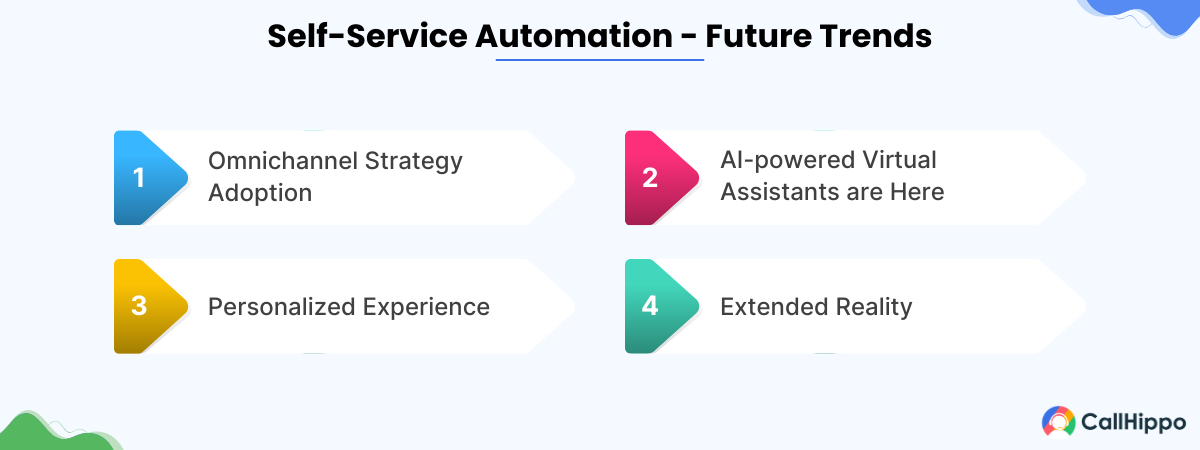
The increase in reliance on self-service has sparked trends in self-service automation to deliver a better and quicker experience to customers.
1. Omnichannel Strategy Adoption
Customers are looking for solutions across different channels like chatbots, voice media, and communities. This has pushed contact centers to adopt an omnichannel strategy that can consistently cater to customers across all channels. The primary goal of this strategy is to resolve queries quickly, eliminate customer detours, and ensure effective interactions.
2. Conversational AI is Moving Toward Personalized Experience
Chatbots often provided robot-like responses in the past as they weren’t equipped to understand customer emotions and intent or customize language with situations. New-age conversational AI is powerful enough to understand customers and personalize experiences on customers’ preferred channels.
3. AI-powered Virtual Assistants are Here
In the past, agents were overburdened and burnt out as they had to deal with huge call volumes on different channels. This directly impacted their well-being and service quality (low customer satisfaction). AI virtual assistants now help agents solve customer problems faster by letting self-service do the heavy-lift. So, they have to deal with fewer customers.
4. Extended Reality is Transforming Customer Experiences
New-age self-service has gone beyond text-based interactions to include extended reality. This reality covers both virtual reality and augmented reality, which has changed how customers interact with services and products. The best example of this reality is furniture brands that let you view your furniture items in your room using virtual reality.
Wrapping Up
Self-service automations are designed to reduce your customer service cost and increase the speed of customer query resolution. That’s only possible when you follow the best practices of implementing self-serve automations and use metrics to gauge and elevate the success of these automations.
Now, you may face some challenges with self-service automations, but there’s nothing to worry about. Just refer to and implement our solutions, and you’re good to go. Or just cut off this hassle and adopt holistic, hyper-personalized, and intuitive self-service automations like chatbots, AI voicebots, and conversational IVR by the best provider, CallHippo.
FAQs
1. What is an automated self-service relationship?
An automated self-service relationship is how business users establish self-service sources and trigger business processes for customers to solve their service requests without waiting to connect with a support agent.
2. What is self-service AI?
Self-service AI is a self-service technology that leverages AI to automate customer interactions.
3. What is the most successful example of self-service?
The most successful example of a self-service automation portal is Amazon’s intuitive and personalized self-service page loaded with information to resolve customer-specific service requests and streamline business processes.

Subscribe to our newsletter & never miss our latest news and promotions.

